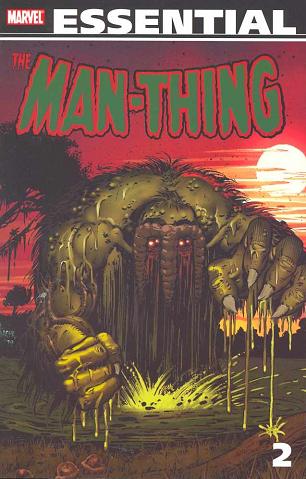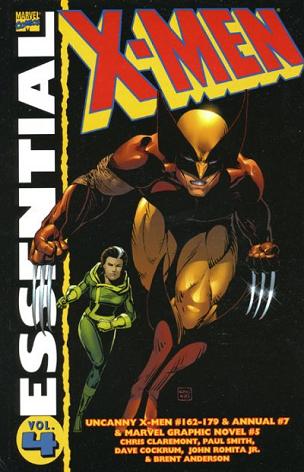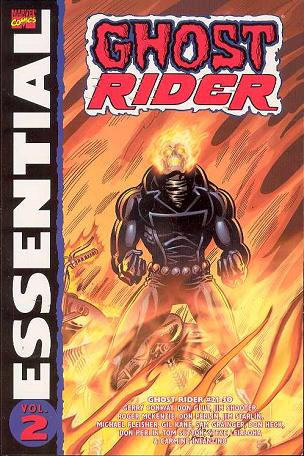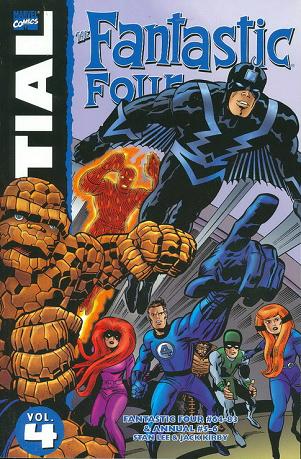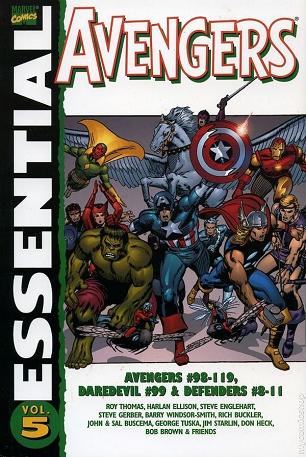
Essential Avengers Vol. 05
Roy Thomas, Steve Englehart, Barry Smith and friends
Reprints: Avengers #98-119, Defenders #8-11, Daredevil #99 (April 1972 – January 1974)
Get this for: The end of Roy Thomas’ and the start of Englehart’s run — four stars
The fourth volume of Essential Avengers ended with the best Avengers story Roy Thomas ever did: the Kree-Skrull War. How can the fifth volume ever improve on this? Well, how about a three issue epic with the Avengers search for their missing member Hawkeye turning up both Hawkeye and ex-member Hercules, pits them against the Olympian god of war Ares as well as the Asgardian goddess the Enchantress and culminating into an epic battle reuniting every Avenger past and present, including the Hulk and the Swordsman?
It’s a good start, especially when the art on these three issues is done by Barry Smith. It’s the best the Avengers look this volume, even though such good artists like John and Sal Buscema, Rick Buckler, Bob Brown and Don Heck are responsible for the art in the rest of the book. they’re good, but Barry Windsor Smith even back then was in a class of his own. You wish he could’ve done the art for longer, but of course he never was the fastest artist in the world and beside, his tourist visum had expired and he was deported…
After the ten issue epic that was the Kree-Skrull War, both Roy Thomas and his succesor Steve Englehart limit themselves to shorter stories for a while. Thomas has the Avengers traveling to Olympus, then plots the return of the Grim Reaper before unleashing the Sentinels again. The X-Men had just been cancelled and so their old villains were fair game for the Avengers, something Englehart would also make use of by letting Magneto attack the Avengers. Englehart also plunders storylines from other series, tying in Captain America’s fight together with Rick Jones against Madame Hydra, in which the latter died, with his own Space Phantom & Grim Reaper teamup, by revealing the former had stood in for the actual Madame Hydra in that earlier Captain America story, hence the real Madame Hydra was still alive. It’s an early example of how complex Marvel continuity could become in the seventies and eighties, with writers building not only on the work done before in their own series, but bringing in loose ends from their own earlier ventures, as well as adding to stories originally done by others.
Though Englehart and Thomas do limit themselves to shorter stories, both let these stories flow more naturally into each other. They’re much less self contained as those Stan Lee wrote originally for The Avengers. This means there’s more room for interpersonal conflict and soap opera and Englehart makes good use of this. Roy Thomas had dropped the first hints that the Scarlet Witch and the Vision might have been attracked to each other; under Englehart their romance, after may false starts, came out in the open. This romance is one of the mainstays of his run here. Another constant in Englehart’s run is Hawkeye’s, well dickishness towards the other Avengers. Always a bit of a hothead, here he’s just obnoxious at times, throwing a hissy fit when the Scarlet Witch choses the Vision rather than him, later getting into an actual fight with Daredevil over the Black Widow, in a Steve Gerber penned issue of Daredevil also collected here. It may not have read that way originally, but here it seems the sexism fairy has visited Hawkeye.
Like the previous volume, this one too ends with a multi issue epic, as Englehart loses his inhibition and starts a story on par with Roy Thomas’ Kree-Skrull War. But this time this epic is not contained in one series, but involves The Defenders as well, which was also written by Englehart at the time. Dormammu and Loki manage to trick the Defenders into finding the six pieces of the Evil Eye, last seen in a Fantastic Four issue in order to cure the Black Knight, but in reality to give Dormammu the power to rule the universe. Loki gets cold feet and involves the Avengers by tricking them into believing the Defenders actually want to rule the world. Chaos, as they say, ensues. The Avengers – Defenders War is the ancestor of all those crossover epics that would excite and bore us later in the eighties and nineties and it already includes that page showing every hero in the world fighting the main villain’s evil hordes all over the world — or at least New York.
This is neither Thomas’ nor Englehart’s finest hour, but this is still a great volume to see how one great writer hands over the baton to another one.
